|
|
|
|
|
|||||||
|
|
Budget 2001 - Budget Plan
- Table of Contents - Previous - Next -
Annex 4
Fiscal Performance of Canada's Federal-Provincial-Territorial Government Sector
Highlights
- The aggregate federal-provincial-territorial government sector recorded an estimated surplus of $29.2 billion in 2000-01, the third consecutive annual surplus.
- In addition to the federal government, eight provinces and two territories are estimated to have recorded surpluses in 2000-01.
- The net public debt-to-GDP (gross domestic product) ratio has fallen at both levels of government. The federal ratio has declined by nearly 19 percentage points from its peak of 70.7 per cent in 1995-96. The aggregate provincial-territorial ratio has declined by 5.5 percentage points from its peak of 28.0 per cent in 1997-98.
- Although declining, debt charges as a per cent of total revenues are still significantly higher at the federal level than at the provincial-territorial level.
- Since 1992-93 program spending as a share of GDP has declined significantly at both levels of government.
- Provincial-territorial revenues are higher than those collected by the federal government. Although revenues as a percentage of GDP are expected to decline at both levels of government, the decline at the federal level should be more pronounced, given the federal government’s $100-billion Five-Year Tax Reduction Plan and strong growth in federal transfers to provinces and territories under existing legislation.
Federal-provincial-territorial governments recorded an aggregate surplus in 2000-01 for the third consecutive year
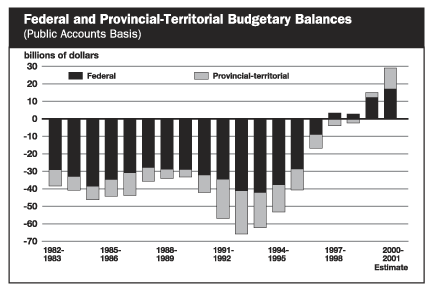
- In 2000-01 federal-provincial-territorial governments are estimated to have recorded an aggregate surplus of $29.2 billion, the third consecutive surplus.
- This represents a remarkable improvement from 1992-93, when the federal-provincial-territorial government sector posted a $65.8-billion deficit.
- From 1993-94 to 2000-01 the federal budgetary balance moved from a deficit of $42 billion to a surplus of $17.1 billion.
- The provincial-territorial government sector is estimated to have recorded a surplus of $12.0 billion in 2000-01, the second consecutive surplus after more than 30 years of uninterrupted deficits.
Most provinces and territories are expected to record budgetary surpluses in 2000-01
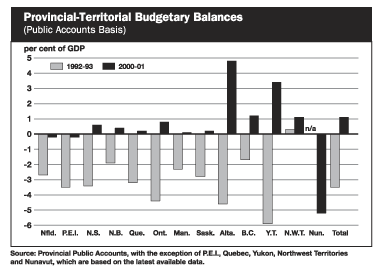
- Eight provinces and two territories are estimated to have recorded a budgetary surplus in 2000-01.
- In contrast, in 1992-93 all but one of the 12 provincial-territorial budgets (Northwest Territories) were in deficit.
Total provincial-territorial revenues consistently higher than federal revenues

- For the last 20 years provincial-territorial revenues have consistently exceeded federal revenues.
- The provincial-territorial revenue-to-GDP ratio is also more stable than the federal ratio as the federal government’s revenues are more sensitive to cyclical variations, given its larger share of personal income tax revenues.
- The federal ratio has declined steadily since 1997-98, reflecting the impact of recent tax measures. It is expected to decline further over the medium term, reflecting the impact of the $100-billion Five-Year Tax Reduction Plan, which will be fully in place by 2004-05.
- In contrast, the provincial-territorial revenue-to-GDP ratio has increased in recent years despite tax cuts, primarily reflecting strong growth in revenue sources unique to the provinces, such as resource royalties and gaming profits.
The provinces will benefit from strong growth in federal cash transfers
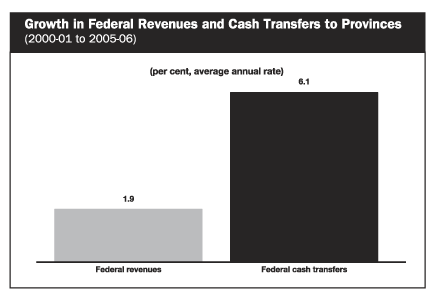
- Total provincial government revenues include both own-source revenues and cash transfers from the federal government for such programs as the Canada Health and Social Transfer (CHST) and equalization. These transfers make up from 7 per cent to 44 per cent of individual provinces’ total revenues.
- With the recent $21.1-billion increase in the CHST over five years and increasing equalization payments, federal cash transfers to the provinces are projected to grow rapidly in the coming years.
- Depending on the growth of provincial fiscal capacities, which have an impact on equalization payments, federal cash transfers could grow by up to 6.1 per cent annually over the next five years. These funds will help the provinces finance key social programs such as health care and education.
- In contrast, federal revenues are forecast to grow at an average annual rate of just 1.9 per cent from 2000-01 to 2005-06.
Program spending has declined significantly as a share of GDP
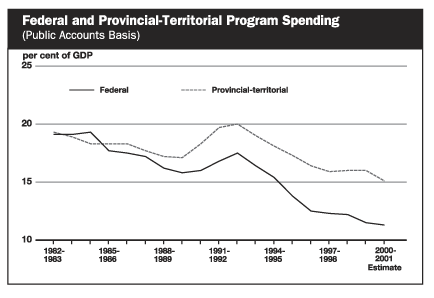
- At both levels of government, deficit elimination has primarily been achieved through program-spending reductions.
- From 1992-93 to 2000-01 federal program spending as a share of GDP fell by 6.2 percentage points – from 17.5 per cent to 11.3 per cent. Over the same period provincial-territorial program spending fell by 4.9 percentage points – from 20.0 per cent to 15.1 per cent.
The debt burden is much larger at the federal level

- Throughout the past decade the federal debt burden, as measured by the ratio of net public debt to GDP, has been more than twice as high as the provincial-territorial debt burden.
- In 2000-01 the federal debt-to-GDP ratio was estimated at 51.8 per cent, a drop of 18.9 percentage points from its peak of 70.7 per cent reached in 1995-96.
- The provincial-territorial ratio was estimated at 22.5 per cent in 2000-01, a decline of 5.5 percentage points from its peak of 28.0 per cent in 1997-98.
Debt charges as a per cent of total revenues are significantly higher at the federal level
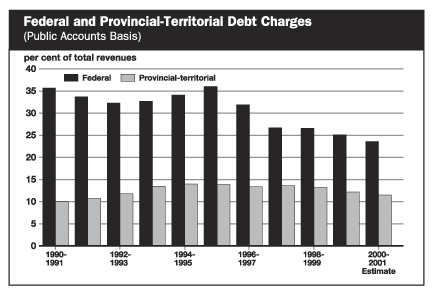
- As a result of its larger debt burden, the federal government faces much higher debt charges than the provincial-territorial government sector.
- The federal government must therefore spend a larger proportion of its revenues on debt charges.
- In 1995-96 the federal government spent 36.0 cents of every dollar of revenue on debt charges. Although significant progress has been made in reducing this burden, federal debt charges still consume 23.6 cents of every dollar of revenue, compared to 11.5 cents for the provincial-territorial government sector.
- Table of Contents - Previous - Next -
| Last Updated: 2001-12-10 | |||||